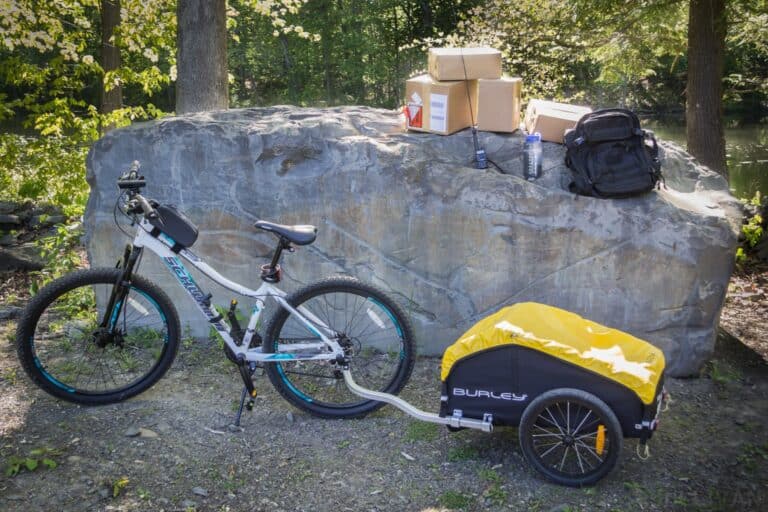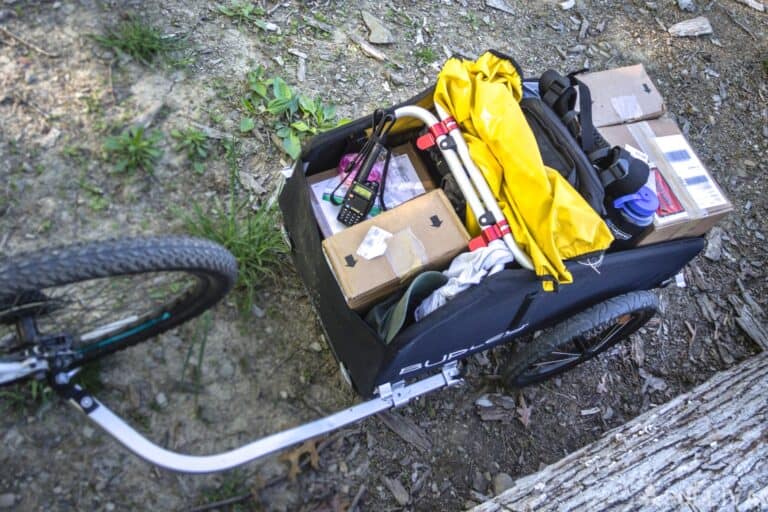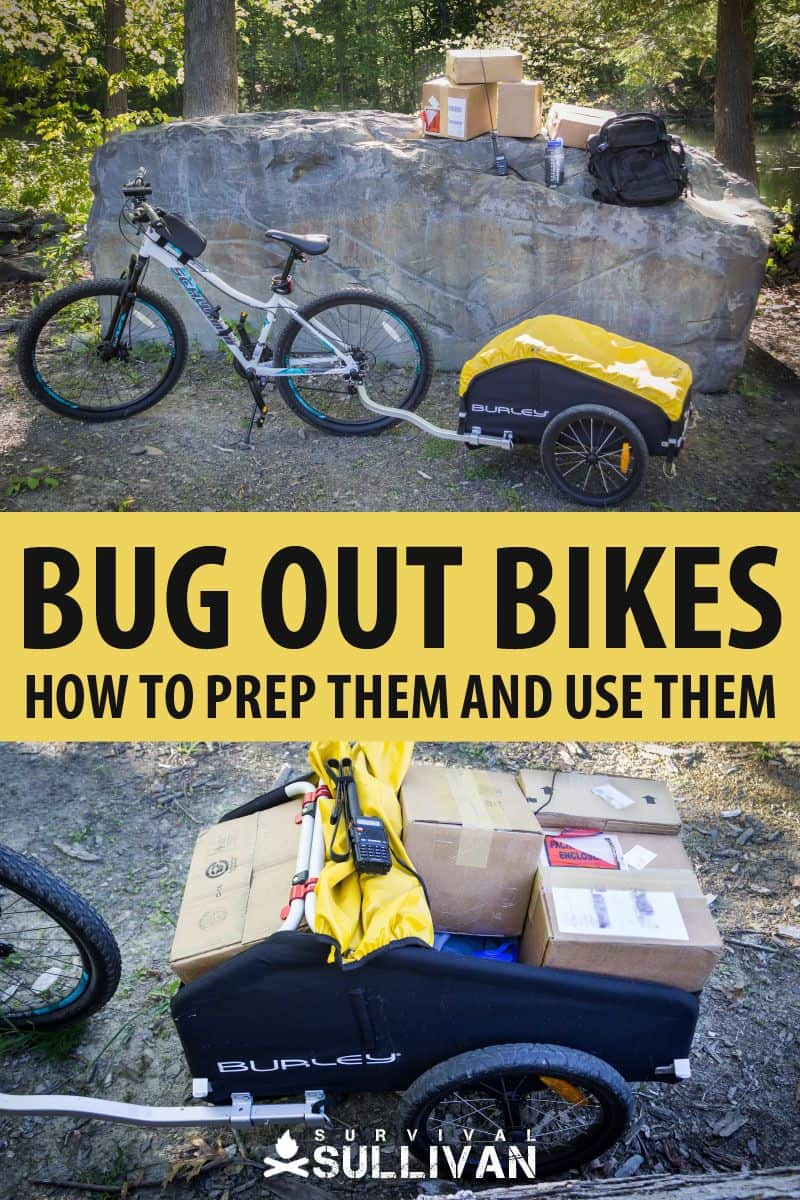It pleased me to read a comment on one of my recent articles. The article was on rural bugout bags. The reader stated:
“Would you consider doing an article on the use of bikes or trikes on long-distance bugouts. Maybe in conjunction with secondary sourcing like online resale or garage sales?”

Finally, thank you for an insightful comment. Oftentimes, we focus on the obvious or the unconventional and disregard the middle ground. It is here we find what history has taught us.
Bicycles have been the bugout vehicle of choice for generations of refugees. We, as a species, like our stuff too much. It follows that when we need to move, even under extreme circumstances, we take too much with us.
Many have learned that you can carry more on a bike than on your back. Let’s look at how you can successfully do this on a bugout.
Table of Contents
Why a Bugout Bike?
Simply put, you should consider a bugout bike so that you can carry more. Well, that’s not quite complete. It’s a good reason, but not the only one.
A bicycle is a mechanical beast of burden. With a solid frame, it can carry your weight, and much more. Bicycles can also transport you quicker than walking, and with less effort.
Used as intended, you can cover significantly more distance on a bike than on foot. Even with a modest pack, the miles tick off when you are on a bike. If you have a short bugout, a bike is an inexpensive option if your car becomes disabled.
If you have a longer bug-out planned but want something that’s lighter weight and more versatile than a car, consider a motorcycle.
In my case, I have a lengthy daily commute and a bike is central to my get-home plan. It is the only way that I can get home in under 3 days if my car is inoperable.
When I was in college, I would pedal out distances greater than my current commute. Sadly, I’m no longer that fit, and the terrain isn’t as flat. Still, it beats walking.
Getting creative, bikes aren’t just for riding. Take a few minutes to do a google image search for:
- “Asia carrying with a bicycle”
- “Africa carrying with a bicycle”
My search results have pictures of bikes with hundreds of pounds of goods. Boxes, firewood, and sacks of good are stacked up many feet high. I’m sure that they are well-practiced, but it proves a point. Bicycles are force multipliers!
Bike Sources
Bikes are found anywhere and everywhere if you look hard enough. With a little patience, you should be able to find the perfect match for your needs.
For those with deep pockets, or a mind to get the best bike in the shortest time cycle shops are the way to go. With one visit you can get the right bike with the right fit and the right accessories. They’ll even assemble it for you. Convenient and potentially expensive.
There is one subtle disadvantage to this approach. If you build and tune your bike you will be in a much better position to affect a repair in times of need. Paying someone else to do this for you denies you of the opportunity to build these skills.
The great news is you don’t only have to go to a store to get a great bike. Bikes are available everywhere. Most are cheap. Many are free.
A quick search of my local craigslist page has 250 entries for “mountain bike’ under $150. About 1/3 are real mountain bikes, and about half of those are in good enough shape for me to consider looking at.
Next, hit local garage sales and flea markets. Garage sales are best bet, as you can usually get a bike for a “I just want it out of here” price that is a fraction of the most reasonable price.
Flea markets are a little tougher as they usually know the value of what they are selling. The challenge is finding one that fits and is in good shape.
Finally, there is “The Freecycle Network”. Similar to craigslist, but free. You will find a mountain of useful, and some non-useful goodies. The local city’s page had a single children’s bike (and a ¼ full bottle of shampoo). You may find a great deal (it’s all free!) or at the least a good bike for parts.
If you find one that is serviceable you can easily tune it up for short money. A bike with a solid frame usually only needs a few parts. This includes new tires, tubes, brakes, and a few cables.
If you have the time, I recommend getting a cheap bike, and bringing it back to life. Learn the TLC skills required for both maintaining AND repairing a bike.
Preparing Your Bugout Bike
As all things preparing, you must do your research. If you want a bike for riding with a BOB, that defines one set of requirements. If you want a bike to haul a trailer, that’s another. If you want a bike to load up and push, not ride, that’s a third set of requirements.
Choosing Your Bugout Bike
There are bikes for every use. Some more specified than others. As we won’t be competing in the Tour de France we don’t need to be as picky. Start with the fundamentals, and work out to accessories.
Choose a bike with sound construction. Next, select a bike that is compatible with your use case. If you need to log many miles over the flat mid-west select one fit for distance.
Lean and mean you can rack up towns, counties, and states. If your route is off-road over hills, look at a mountain bike, or even one with fat tires that can handle snow, mud, and streams.
Next, (if you plan on riding it) confirm proper fit. Logging a few days on a bike that is too small is uncomfortable at best, dangerous at worse. This includes all members of your family. If you will be traveling with little ones, plan ahead. They grow.
Finally, consider expansion and accessories. I’m good with tools and have an engineering mind. I’d still rather get an accessory built specifically for my bike than have to rig up something.
It will never be as good as something that was designed to fit. Murphy will find a way to make it fail at the worst possible time.
Strong Bones
Ultimately, your bike selection depends on your bugout use. You need to confirm that your bike is structurally sound. This includes the frame, tires, and handlebars.
Check the frame for cracks. Go over the integrity of all the joints. Welded joints, brazed joints, and lugged brazed joints must all be free of cracks and other signs of fatigue. The last thing you need on a bugout is 300lbs of gear spilled all over the trail with a frame that has broken in half.
Next check the tires. Tubes and tires are cheap. They have a limited life, so replace them. Whether it is through wear or dry-rot, they don’t last forever. During your seasonal bugout bag review (You are doing these, right? Seriously, right?) take a close look at your tires.
Wear will be obvious, dry rot not so. Check for changes in coloration, texture (the rubber will be harder and brittle). Look for signs of cracking at the base of the treads or near the rim. Any signs of excessive wear or rot – replace them.
While you can use a bike to haul gear without a chain or pedals, you will always need functioning handlebars. Check for wobble at speed, looseness of the handlebars, and rattling. A little grease and bolt tightening will fix 90% of your issues.
Brakes
Whether you ride or push your bugout bike you will need to have quality brakes. Pushing a bike that gets out of control and rolls off down a hill is a sure way to lose or ruin your precious gear.
When using a second-hand bike, you will need to review their function. Check the pads for wear, and make sure the brake cables move freely.
Check the calipers to confirm that both pads make contact with the rim. Check that neither one drags when the cables are loose. Complete your break tune-up by oiling the cables and calipers.
If you need to replace them, brakes and cables are inexpensive and are replaceable in less than an hour. You have no excuse to have insufficient braking power.
Paint
Paint is one of the easiest characteristics to change on your bike. Most bikes are painted to attract attention. When you are on the road you want to stick out. On our “road” it’s a much different story.
Strip off all reflectors, and get out the rattle cans. It’s not necessary to be Picasso. Knock down all shiny surfaces. Frame, handlebars, rims, and spokes. Everything gets a coat. If you want to be creative, match the paint to your area. Otherwise, just dulling the finish is sufficient.
Accessories (Racks, Carts, Repair Kits)
A bike is good to move “you” from point A to B. However, under the condition of a bugout “you” will be accompanied by a bunch of gear. That gear must include a tool kit, repair kit, and a mini tire pump.
Accidents happen. They seem to find the absolute worst time to appear. You must have the ability to fix the most common malfunctions. These include thrown chains, broken cables, and flat tires.
Include in your pack a simple repair kit. It should contain the tools and spares you’ll need to address the most common issues. A set of English and metric open-ended wrenches, hex wrenches, screwdrivers, and pliers should suffice.
Disclosure: This post has links to 3rd party websites, so I may get a commission if you buy through those links. Survival Sullivan is a participant in the Amazon Services LLC Associates Program. As an Amazon Associate, I earn from qualifying purchases. See my full disclosure for more.
Repair supplies will be a bit more specific to your bike. Pick up spare tubes, brakes, and cables. Don’t forget a hand pump. Amazon has many kits from minimalist to complete.
You will have difficulty carrying more than your BOB without rigging up a series of attachment points on your bike. Without a minimal rack, you will need to modify your gear to attach to your frame, seat, and handlebars. It’ll be much easier to get a dedicated rack system.
Racks come in all shapes and sizes. Pick up a set that fits your bike, and goes over the rear tire. This is the most stable position to store gear. If you have the cash, get a second that goes over the front tire.
Commercial racks and bags that offer well-organized storage designed to be easily removed for a quick getaway are everywhere.
You can also store gear on the handlebars. This is a great area for the storage of your highest priority items. Make sure that you can rapidly remove it if you have to ditch the bike.

Finally, there is the option to haul a small trailer. This is a very efficient way to carry bulk items. Separate from your personal space they give you more room to move.
More importantly, they don’t affect your center of gravity. You will have enough challenges pedaling with a BOB without the added complication of 50 pounds of gear above your rear tire.
Most trailers will carry 50-100 pounds. The biggest advantage is that you can load a trailer with less attention paid to load balance.
Other Gear
The glorious thing about a bugout bike is that it can carry much more gear than your back and aching knees. Depending on your specific setup you can expect to easily carry an additional 100 pounds of gear.
With a few upgrades (forks, brakes, rims, and tires) you can achieve several hundred pounds of additional carrying capacity.
First include the essentials of water, food, health/sanitation, and security. If traveling through a dry area or during a dry season you can afford to include a few gallons. Same with food. You can afford a few luxury foods and skip the freeze-dried components.
Traveling a long-distance? You will have room to pack a more substantial medkit. Don’t forget a camouflage tarp and a good knife or hatchet to harvest local greens for additional camouflage during your overnight stays.
Loading
Loading a bike lands somewhere between art and science. Most of all, it involves experimentation.
You have six positions for your load. Up, down, front, back, left, and right. Up and down is easy. Lower is better.
The higher the load, the less stable you will feel and the more you will have to fight to keep your balance. Keep your gear below your handlebars and seat.
Where possible position loads as close to the axels as possible. When not possible, put the heavier gear in the lowest position.
Left to right is also simplistic. Keep your load balanced. Having one side heavier unbalances you. Especially on the front wheel at speed.
Experiment with each load point (rack, bag, tie-down, etc.). By swapping just two pieces of gear it may be possible to achieve a better balance.
Front to back has less impact but still requires some trial and error. With weight on the front hills will be easier to climb, however, you will be less stable on downhills. Again experiment!
One critical concern – always keep the load over the front tire as balanced as possible. Failure to do this will cause excessive wobble at speed.
Finally, you must consider your tie-downs. The rule for camping, off-roading, or biking is – if you want to lose something use bungee cords.
On your bike, especially when carrying maximum loads, use quality straps and buckles. Be sure that they allow you to tighten and secure with no loosening.
Finally, once you hit the road rotate riding order every once in a while. As you juggle position, make sure to check out each other’s gear for loose tie-downs.
Bugging Out
Using a bike to get to your Bugout Location (BOL) will present a series of unique challenges. On foot, you can overcome almost any obstacle by going over it, under it, or around it.
Of course, this depends on your tolerance for heights, as well as your ability to swim.
Trail Selection
On a bike, you have a few limitations. Bikes excel on smooth trails, however, they have limitations off-road. Equally, water hazards that you can swim with a pack may become impassable with a bike.
Each of these limitations will restrict your available routes. This is the cost of covering ground at speed.
When planning your bugout route consider back roads and rail trails. In my area, we are blessed with a rail trail covering the first 60 miles to our BOL. Rail trails are flat, well-groomed, and a joy to ride.
Criss-crossing our country are high tension power lines. Most power lines have a trail. Whether made by man or animal, they are almost always there. Unfortunately, they also go through wetlands and may be impassable.
Another potential for bike travel in the north is snowmobile trails. Well maintained, although not as good as rail trails, they can cover vast distances.
When on a bike it doesn’t take much more than a log across the trail to stop your progress. Review any trail you plan on taking. Know the risky areas as well as the impassable areas. For each section have one or two alternate routes.
Stopping and re-routing on a bike can be more difficult than with a pack. Worst case scenario you will have to partially unload and “portage.”
Individually moving your bike and gear around the obstacle only then to re-assemble is demoralizing. I don’t think I need to express the level of effort and frustration associated with doing this once, let alone multiple times in a day.
Stopping For The Night
Taking breaks on your bugout bike requires a little more time compared to a bugout on foot. Once you stop you will need completely hide both yourself and your bike. Leaving your bike alone while you sleep is pure folly.
A few hours before dark start looking for a place to stay. Even if it takes several trips, take all your gear and your bike at least 100 yards off the trail. Use your camouflage tarp to cover your gear. It will even help to trim local foliage to further cover up your gear and break up its outline.
Maximize your light, sound, and smell discipline. Get fed and under cover before nightfall to eliminate flashlight use. Don’t start a fire unless you absolutely have to. Even then use a Dakota fire hole or a camp stove to reduce both light and smell.
At first light, move back to the trail. Cover as much ground before you need to break again.
Even better, if you have the tools and ability to travel at night. It will be slow going at night on bikes. You will need both open trails and night vision. If you can own the night, then move at night and rest during the day. You will avoid 90% of humanity this way.
Repairs
Flat tires and repairs happen. Murphy makes a living at it. There is a good chance that you will need to unload all your gear to make your repair. Take your time, and if possible, get off the trail.
Efficiency comes from practice. Become comfortable patching tubes, re-tensioning cables, adjusting gears, and all the common repairs. On a bugout, time will be of the essence. The bugout trail is not the place, and an emergency is not the time, to be learning how to make repairs.
Wrap-up
A bugout bike can be a great asset. When your bugout requires that you cover great distances over a short time, there are few tools as well suited as a bugout bike. Short of a working vehicle, a bike will get the job done efficiently and effectively.
You can find a bike in a yard sale, online, or at a professional bike store. From free to several hundreds of dollars there is one that fits your size and budget. It just takes a little looking. Once you have found one learn to maintain it, fix it, then accessorize it.
Your goal should be to fit all you planned supplies comfortably and in a manner that facilitates quick and easy movement. With a little planning and practice, you can dramatically cut your bugout time. When time is of the essence, hop on your bugout bike and ride!


My passion is empowering people with the knowledge to prepare for personal, local, and regional emergencies. I went to school for engineering and computer science and spend my days in the security industry.

Thank you for the great article, especially the tips on repairs and road security. Our grandkids have now inherited their parents bug out bikes but their parents still talk about our Sunday rides to the BOL and the junkfood runs that evening in my truck. My wife feels the same way about her quiet Sundays! I was wondering if you would consider sharing any tips and insights into using those bikes at a BOL for transport, security or patrolling at the BOL? My brother was asking for his family, in another state and my ideas were rather shallow and unhelpful. Thanks again for the great article. It will help a lot of people with long trips home!
Nice article. I would like to hear more about choices for trailers. Also, “breaks” refer to taking a break. “Brakes” are what stop a vehicle in motion.